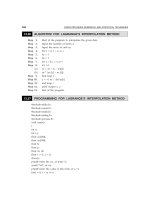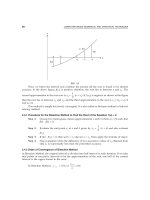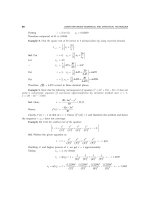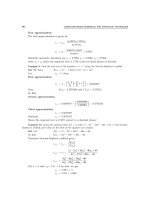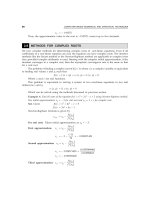A textbook of Computer Based Numerical and Statiscal Techniques part 21 docx
Bạn đang xem bản rút gọn của tài liệu. Xem và tải ngay bản đầy đủ của tài liệu tại đây (100.1 KB, 10 trang )
186
COMPUTER BASED NUMERICAL AND STATISTICAL TECHNIQUES
Take the mean of equation (1) and (2)
22
(0) (1) (0) ( 1)
(1) (1)
() (0)
22 2!2
ff f f
uu uu
fu f
+∆+∆−
−+ −
=+ ∆+
44
3
(1) (2)
( 1) 2) ( 1) ( 1) ( 1)( 2)
(1)
3! 2 4! 2
ff
uu u u u uu u
f
∆−+∆−
−−++ +−−
+∆−+
+
55
(3)(1)(2)(2)
(1)(1)(2)
5! 2
ufuf
uuu u
−∆ −+ +∆ −
+−−
+
{}
()
22
3
1
(1)
(0) (1) (0) ( 1)
1(1)
2
() (0) 1
222! 2 3!
uu u
ff f f
uu
fu u f f
−−
+∆+∆−
−
=+−∆+ + ∆−
()
44
5
1( 1)( 2)( 12)
(1) (2)
(1)(1)(2)
( 2)
4! 2 5!
uuu u u
ff
uuu u
f
+−−−
∆−+∆−
+−−
++∆−+
This formula is very useful when
1
2
u =
and gives best result when
13
44
u<<
.
4.4.5 Laplace-Everett’s Formula
Gausss forward formula is given by
23 4
(1) (1)(1) (1)(1)(2)
() (0) (0) (1) (1) (2)
2! 3! 4!
uu u uu u uu u
fu f uf f f f
−+−+−−
= +∆ + ∆−+ ∆−+ ∆−
56
( 2)( 1) ( 1)( _ 2) ( 1) ( 1)( 2)( 3)
(2) (2)
5! 5!
uuuuu uuuuu
ff
++ − + −−−
+∆−+∆−+
(1)
We know
322
544
(0) (1) (0)
( 1) (0) ( 1)
(2) (1) (2)
fff
fff
fff
∆= −
∆−=∆ −∆−
∆−=∆−−∆−
Therefore, using this in equation (1), we get
[]
222
(1) (1)(1)
( ) (0) (1) (0) ( 1) ( (0) ( 1))
2! 3!
uu u uu
fu f uf f f f f
−+−
=+ − + ∆−+ ∆ −∆−
()
444
( 1) ( 1)( 2) ( 2)( 1) ( 1)( 2)
(2) (1) (2)
4! 5!
uuu u u uuu u
fff
+−− ++−−
+∆−+ ∆−−∆−+
22
(1) (1)(1)
(1 ) (0) (1) ( 1) ( 1)
2! 3!
uu u uu
uf uf f f
−+−
=− + + ∆ −− ∆ −
24
( 1) ( 1) ( 2)( 1) ( 1)( 2)
(0) ( 1)
3! 5!
uuu u uuu u
ff
+− ++−−
+∆+ ∆−
+
44
( 2)( 1) ( 1)( 2)
(1)(1)(2)
( 2) ( 2)
4! 5!
uuuuu
uuu u
ff
++ −−
+−−
∆−− ∆−
INTERPOLATION WITH EQUAL INTERVAL
187
22
(1)(2) (1)(1)
(1 ) (0) (1) ( 1) (0)
3! 3!
uu u u uu
uf uf f f
−− + −
=− + + ∆ −+ ∆
44
(2)(1)(1)(2) (1)(1)(2)(3)
(1) (2)
5! 5!
u u uu u u uu u u
ff
++ −− + −−−
+∆−+∆−+
24
( 1)( 1) ( 2)( 1) ( 1)( 2)
( ) (1) (0) ( 1)
3! 5!
uu u u u uu u
fu uf f f
+− ++ −−
=+ ∆+ ∆−+
+
{}
24
(1)(2) (1)(1)(2)(3)
(1 ) (0) ( 1) ( 2)
3! 5!
uu u u uu u u
uf f f
−− + −−−
−+ ∆−+ ∆−+
(2)
Substitute 1 – u = w in second part of equation (2)
24
( 1) ( 1) ( 2)( 1) ( 1)( 2)
( ) (1) (0) ( 1)
3! 5!
uuu u uuu u
fu uf f f
+− ++−−
=+ ∆+ ∆−+
+
()
24
1( 1)
( 2)( 1) ( 1)( 2)
(0) ( 1) ( 2)
3! 5!
www
wwwww
wf f f
−+
++ −−
+∆−+ ∆−+
This is called Laplace-Everett’s formula. It gives better estimate value when
1
2
u >
.
Example 1. From the following table, find the value of e
1.17
using Gauss forward formula:
x
x
efx
=
1 1.05 1.10 1.15 1.20 1.25 1.30
( ) 2.7183 2.8577 3.0042 3.1582 3.3201 3.4903 3.6693
Sol. The difference table is as given:
23456
1 2.7183
0.1394
1.05 2.8577 0.0071
0.1465 0.0004
1.10 3.0042 0.0075 0
0.154 0.0004 0
1.15 3.1582 0.0079 0 0.0001
1.619 0.0004 0.0001
1.20 3.3201 0.0083 0.0001
0.1702 0.0005
1.25 3.4903 0.0088
0.179
1.30 3.6693
xy
∆∆∆∆∆∆
188
COMPUTER BASED NUMERICAL AND STATISTICAL TECHNIQUES
Now, let taking origin at 1.15, here h = 0.05
Then,
1.17 1.15
0.4
0.05
u
−
==
On applying Gauss’s forward interpolation, we have
23 4
(1) (1)(1) (1)(1)(2)
() (0) (0) (1) (1) (2)
2! 3! 4!
uu u uu u uu u
fu f uf f f f
−+−+−−
= +∆ + ∆−+ ∆−+ ∆−
5
(2)(1)(1)(2)
(2)
5!
uuuuu
f
++ −−
+∆−+
(0.4)( 0.6) (1.4)(0.4)( 0.6)
(0.4) 3.1582 0.4 (0.1619) (0.0079) (0.0004)
26
f
−−
=+×+ ×+ ×
(1.4)(0.4)( 0.6)( 1.6)(2.4)
0 0.0001
120
−−
++ ×
(0.4) 3.1582 0.06476 0.000948 0.0000224 0.0000010752f =+ − − +
(0.4) 3.22199 (Approx.)f =
Example 2. Given that
x
x
25 30 35 40 45
log 1.39794 1.47712 1.54407 1.60206 1.65321
log 3.7 = ?
Sol.
234
2
1
0
1
2
log log log log log
25 1.39794
0.07918
30 1.47712 0.01223
0.06695 0.00327
35 1.54407 0.00896 0.00115
0.05799 0.00212
40 1.60206 0.00684
0.05115
45
1.65321
xxx xxx
x
x
x
x
x
−
−
∆∆ ∆ ∆
−
−−
−
x = a + hu, x = 37, a = 35, h = 5
u =
37 35
0.4
5
xa
h
−−
==
INTERPOLATION WITH EQUAL INTERVAL
189
23 4
(1) (1)(1) (1)(1)(2)
() (0) (0) (1) (1) (1)
2! 3! 4!
uu u uu u uu u
fu f uf f f f
−+−+−−
= +∆ + ∆−+ ∆−+ ∆−
(0.4)(0.4 1) (0.4)(0.4 1)(0.4 1)
1.54407 0.4 0.05798 ( 0.00896) (0.00212)
26
−−+
=+×+ ×−+ ×
(0.4)(0.4 1)(0.4 1)(0.4 2)
( 0.00115)
24
−+−
+×−
( ) 1.54407 0.023192 0.0010752 0.00011872 0.00002576fu=+ + − −
= 1.56819272
Since log 3.7 =
3.7 10 37
log log
10 10
×
=
⇒ log 3.7 = log 37 – log 10 = 1.56819272 – 1 = 0.56819272. Ans.
Example 3. From the following table find y when x = 1.45.
x
y −−++
1.0 1.2 1.4 1.6 1.8 2.0
0.0 0.112 0.016 0.336 0.992 2.0
Sol.
xy y y yy∆∆∆∆
−
−
−
234
1.0 0.0
0.112
1.2 0.112 0.208
0.096 0.048
1.4 0.016 0.256 0
0.352 0.048
1.6 0.336 0.304 0
0.656 0.048
1.8 0.992 0.352
1.008
2.0 2.0
()
23 4
1( 1)
(1) (1)(1)(2)
() (0) (0) (1) (1) (2)
2! 3! 4!
uuu
uu u uu u
fu f uf f f f
+−
−+−−
=+∆+ ∆−+ ∆−+ ∆−
1.45 1.4
0.25
0.2
u
−
==
(0.25)( 0.75) (0.25)( 0.75)(1.25)
( ) 0.016 0.25 0.352 0.256 0.048
26
fu
−−
=− + × + × + ×
= 0.047875
190
COMPUTER BASED NUMERICAL AND STATISTICAL TECHNIQUES
Example 4. Use Gauss’s forward formula to find a polynomial of degree four which takes the
following values of the function f(x):
x 12345
f(x) 1–11–11
Sol. Taking center at 3 i.e., x
0
= 3 and h = 1
u =
0
xx
h
−
⇒ u = x – 3
Now, for the given data difference table becomes:
xfxfxfxfxfx∆∆∆∆
−
−
−
−
−
−
234
() () () () ()
11
2
21 4
28
31 4 16
28
41 4
2
51
Gauss forward formula is
23 4
(1) (1)(1) (1)(1)(2)
() (0) (0) (1) (1) (2)
2! 3! 4!
uu u uu u uu u
fu f uf f f f
−+−+−−
=+∆+ ∆−+ ∆−+ ∆−
()
3( 4)( 2)
(3)(4) (2)(3)(4)(5)
1 ( 3)( 2) ( 4) (8) (16)
26 24
xxx
xx xxxx
x
−−−
−− −−−−
=+ − − + − + +
=
232 432
4 104 2 28 142 308
1 2 6 2 14 24 12 32 80
333333
xxx xx x xx x x−+− + −+ − − −+ − + − +
43 2
2 100
() 8 56 31
33
fx x x x x∴=−+ −+
. Ans.
Example 5. Use Gauss’s forward formula to find
30
y
for the following data.
yyyyy
21 25 29 33 37
18.4708 17.8144 17.1070 16.3432 15.5154
Sol. Let us take the origin at
x = 29
then
30 29 1
0.25
44
u
−
===
INTERPOLATION WITH EQUAL INTERVAL
191
Now, for the given data difference table is:
xy y y y y∆∆∆∆
−
−
−−
−−
−−
−
−
234
21 18.4708
0.6564
25 17.8144 0.0510
0.7074 0.0054
29 17.1070 0.0564 0.0022
0.7638 0.0076
33 16.3432 0.0640
0.8278
37 15.5154
Putting these values in Gauss forward interpolation formula, we have
0.25
(0.25)( 0.750)
17.1070 (0.25) ( 0.7638) ( 0.0564)
2
y
−
=+×−+ ×−
+
(0.25)( 0.750)(1.25) (1.25)(0.25)( 0.750)( 1.75)
( 0.0076) ( 0.0022)
624
−−−
×− + ×−
y
0.25
= 17.1070 – 0.19095 + 0.0052875 + 0.00002968 – 0.00000375
y
0.25
= 16.9216. Ans.
PROBLEM SET 4.3
1. The values of e
–x
at x = 1.72 to x = 1.76 are given in the following table:
()
1.72 1.73 1.74 1.75 1.76
0.17907 0.17728 0.17552 0.17377 0.17204
x
fx
Find the values of e
–1.7425
using Gauss forward difference formula
[Ans. 0.1750816846]
2. Apply Gauss’s forward formula to find the value of f(x) at x = 3.75 from the table:
()
2.5 3.0 3.5 4.0 4.5 5.0
24.145 22.043 20.225 18.644 17.262 16.047
x
fx
[Ans. 19.407426]
3. Apply Central difference formula to obtain f(32). Given that :
f(25) = 0.2707, f(30) = 0.3027, f(35) = 0.3386, f(40) = 0.3794. [Ans. 0.316536]
4. Apply Gauss forward formula to find the value of U
9
, if
u(0) = 14, u(4) = 24, u(8) = 32, u (12) = 35, u(16) = 40 [Ans. 33.1162109]
192
COMPUTER BASED NUMERICAL AND STATISTICAL TECHNIQUES
5. Apply Gauss forward formula to find a polynomial of degree three which takes the values
of y as given on next page:
2 46810
213820
x
y −
23
17 3 2
3
62 3
xx x
+++
Ans.
6. Use Gauss’s forward formula to find the annuity value for 27 years from the following
data:
15 20 25 30 35 40
10.3797 12.4622 14.0939 15.3725 16.3742 17.1591
Year
Annuity
[Ans. 14.643]
7. Use Gauss’s forward formula to find the value of f(x), when
1
,
2
x =
given that:
()
210 1
100 108 105 110
x
fx
−
GAUSS BACKWARD
Example 1. Given that
50 51 52 53 54
tan 1.1918 1.2349 1.2799 1.3270 1.3764
x
x
°
°
Using Gauss’s backward formula, find the value of tan 51° 42′
Sol. Take the origin at 52° and given h = 1
∴
51 42 52 18 0.3
xa
uxa
h
−
′′
==−=°−°=−=−°
Now using Gauss backward formula
f(u) = f(0) + u
∆
f (–1) +
()
()
2
1
1
2!
uu
f
+
∆−
()()
()
()()()
3
11 211
2
3! 4!
uuu u uuu
f
+− ++−
+∆−+
()
4
2
f
∆−
INTERPOLATION WITH EQUAL INTERVAL
193
Difference table for given data is:
23
50 1.1918
0.0431
51 1.2349 0.0019
0.045 0.0002
52 1.2799 0.0021
0.0471 0.0002
53 1.3270 0.0023
0.0494
54 1.3764
xtanx°°∆∆∆
From equation (1)
f(–0.3
°
) = 1.2799 + (–0.3) (0.045) +
()() ()()()
0.3 0.7 0.3 0.7 1.7
0.0021 0.0002
26
−−
×+ ×
= 1.2799 – 0.0135 – 0.0002205 – 0.0000119
= 1.266167 (Approx.)
Example 2. Apply Gauss backward formula to find sin 45
°
from the following table
Sin
θ°
θ°
20 30 40 50 60 70 80
0.34202 0.502 0.64279 0.76604 0.86603 0.93969 0.98481
Sol. Difference table for given data is:
2345
20 0.34202
0.15998
30 0.502 0.01919
0.14079 0.00165
40 0.64274 0.01754 0.00737
0.12325 0.00572 0.01002
50 0.76604 0.02326 0.00265
0.09999 0.00307 0.00179
60 0.86603 0.02633 0.00086
0.07366 0.00221
70 0.93
sin
θ°
θ° ∆∆∆∆∆
−
−−
−
−
−−
−
−
969 0.02854
0.04512
80 0.98481
−
194
COMPUTER BASED NUMERICAL AND STATISTICAL TECHNIQUES
∴
u =
xa
h
−
=
45 40
10
−
=
5
10
= 0.5
Now using Gauss backward formula
f(u)= f(0) + u
f∆
(–1) +
()
1
2!
uu
+
()
2
1
f
∆−
+
()()
11
3!
uuu
+−
()
3
2
f
∆−
+
()()()
21 1
4!
uuuu
++ −
()
4
2
f
∆−
+
()()()()
21 12
5!
uuuuu
++ −−
()
5
2
f
∆−+
f(0.5) = 0.64279 + 0.5
×
0.14079 +
0.5 1.5
2
×
×
(–0.01754) +
()
0.5 1.5 0.5
6
×−
×
(0.00165)
+
()()
0.5 1.5 0.5 2.5
24
×−
×
(–0.00737)
= 0.64279 + 0.070395 – 0.0065775 – 0.000103125 + 0.00028789
= 0.706792. Ans.
Example 3. Apply Gauss backward formula to find the value of (1.06)
19
if
(1. 06)
10
= 1.79085, (1.06)
15
= 2.39656, (1. 06)
20
= 3.20714, (1.06)
25
= 4.29187, (1.06)
30
= 5.74349
Sol. The difference table is given by
xy ∆∆ ∆ ∆
234
10 1.79085
0.60571
15 2.39656 0.20487
0.81058 0.06928
20 3.20714 0.27415 0.02346
1.08473 0.09274
25 4.29187 0.36689
1.45162
30 5.74349
∴
u =
xa
h
−
=
19 20
5
−
= – 0.2
From Gauss backward formula
f(u) = f(0) + u
f∆
(–1) +
()
1
2!
uu
+
()
2
1
f
∆−
+
()()
11
3!
uuu
+−
()
3
2
f
∆−
+
()()()
21 1
4!
uuuu
++ −
()
4
2
f
∆−
+
f(u) = 3.20714 – 0.2
×
0.81058 –
()
0.2 0.8
2
×
0.27415 –
()( )
0.2 0.8 1.2
6
−
×
0.06928
+
()
()
()
0.2 0.8 1.2 1.8
24
−
×
0.02346
INTERPOLATION WITH EQUAL INTERVAL
195
f(u) = 3.20714 – 0.162116 – 0.021932 + 0.002216 + 0.00033782
= 3.0256458 (Approx.)
Example 4. Using Gauss backward formula, Estimate the no. of persons earning wages between Rs.
60 and Rs. 70 from the following data:
()
()
Wages Rs Below
No of Persons in thousands
−−− −
. 40 40 60 60 80 80 100 100 120
. 250 120 100 70 50
Sol. Difference table for the given data is as:
Wages below No of Persons y y y y∆∆∆∆
−
−
−
−
234
.
40 250
120
60 370 20
100 10
80 470 30 20
70 10
100 540 20
50
120 590
∴
u =
xa
h
−
=
70 80
20
−
=
10
20
−
= – 0.5
From Gauss backward formula
f (0.5) =
23
(1) (1)(1)
(0) ( 1) ( 1) ( 2)
2! 3!
uu uuu
fuf f f
++−
+∆− + ∆ − + ∆ −
4
(2)(1)(1)
(2)
4!
uuuu
f
++ −
+∆−+
=
( 0.5)(0.5) ( 0.5)(0.5)( 1.5)
470 ( 0.5) ( 100) ( 30) ( 10)
26
−−−
+− ×+ + ×− + ×−
+
( 0.5)(0.5)( 1.5)(1.5)
(20)
24
−−
×
=
470 50 3.75 0.625 0.46875−+ − +
= 423.59375
Hence No. of Persons earning wages between Rs. 60 to 70 is 423.59375 – 370 = 53.59375 or
54000. (Approx.)
